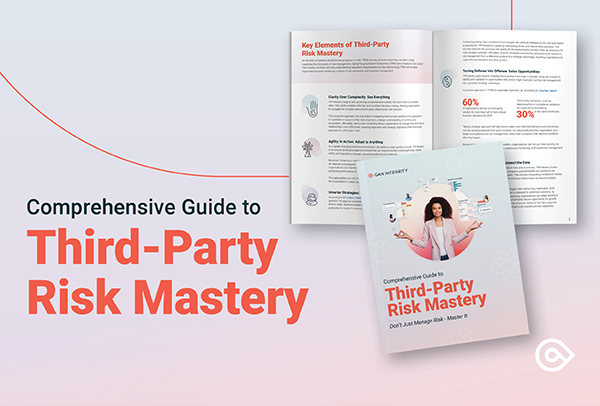In today’s interconnected business landscape, third-party relationships are essential for operational agility, growth, and innovation. However, these relationships also introduce a spectrum of risks that compliance teams must manage, ranging from data breaches and regulatory violations to reputational harm.
While high-risk third parties often command the lion’s share of attention and resources, the medium-high risk category is frequently overlooked, despite its potential to cause significant disruption.
This blog post explores why due diligence for medium-high risk third parties is critical, the unique challenges they present, and how modern due diligence solutions can help compliance teams manage this risk tier efficiently and effectively.
What Are Medium-High Risk Third Parties?
Medium-high risk third parties (often classified as Tier 2 in risk tiering models) occupy a distinct space in the risk landscape. They are more critical than low-risk vendors but do not rise to the level of those considered high risk.
Typically, these third parties:
- Have access to sensitive but not mission-critical data or systems
- Provide services or products that are important to business operations but not absolutely essential for organizational survival
- Present moderate levels of regulatory, financial, or reputational risk if something goes wrong
What Sets Them Apart?
Unlike high-risk third parties, whose failure or misconduct could immediately threaten core business operations or regulatory standing, medium-high risk vendors are less likely to cause existential harm. However, the impact of their failure or non-compliance can still be substantial, triggering operational delays, regulatory scrutiny, or reputational damage.
Medium-high risk third parties often:
- Interact with confidential information but may not process large volumes of personally identifiable information (PII)
- Support key business functions (e.g., specialized IT services, regional logistics providers, niche consultants)
- Operate in regulated industries or geographies, increasing the complexity of compliance requirements
Examples of these types of third parties can include:
- A regional payroll processor handling sensitive employee data for a multinational company
- A cloud-based software provider with access to non-public business information
- A logistics firm responsible for a critical supply chain segment, but not the entire operation
These vendors are not as critical as, say, a primary banking partner or a core IT infrastructure provider, but their failure could still result in regulatory fines, data loss, or significant business disruption.
The Often-Overlooked Risk Category
Lower Priority, But Not Low Risk
Medium-high risk third parties often fall into a compliance “blind spot.” They are not so high-risk as to demand the most rigorous, resource-intensive due diligence, but they require more scrutiny than low-risk vendors, who may only need basic screening. The result is that compliance teams, pressed for time and resources, may deprioritize them—sometimes to their detriment.
More Effort Than Low Risk
Managing medium-high risk third parties demands more than just a periodic questionnaire or a basic background check. These vendors may require:
- More frequent reassessment (every 18 months to two years, as opposed to less frequent reviews for low-risk vendors)
- Enhanced documentation of controls, policies, and regulatory compliance
- Ongoing monitoring for emerging risks, adverse media, or regulatory changes
Why Due Diligence Still Matters
Regulators increasingly expect organizations to demonstrate a risk-based approach to third-party management. This means that even medium-high risk vendors must be subject to appropriate due diligence and monitoring. Failure to do so can result in:
- Regulatory penalties for non-compliance
- Reputational damage from undiscovered issues
- Operational disruptions if a medium-high risk vendor fails to deliver or is involved in misconduct
Best Practices for Managing Medium-High Risk Third Parties
Effectively managing medium-high risk third parties requires a balance of efficiency, rigor, and adaptability. Here are key best practices to help compliance teams address this important risk category:
Comprehensive Risk Categorization
Maintain an up-to-date inventory of all third parties. Use a standardized risk tiering framework to assign and regularly review risk levels, ensuring medium-high risk vendors receive appropriate attention.
Robust Due Diligence at Onboarding
Conduct thorough due diligence at onboarding, including background checks, financial reviews, and compliance verifications. Reassess vendors regularly, especially after significant changes in their business or risk environment.
Clear Contractual Safeguards
Include specific compliance, security, and incident notification requirements in contracts. Require cooperation with audits and timely reporting of any issues.
Stakeholder Collaboration
Involve relevant departments (legal, IT, procurement, business units) in risk assessment and ongoing management. Foster open communication to ensure risks are identified and addressed promptly.
Documentation and Auditability
Keep clear records of due diligence, risk assessments, monitoring, and remediation activities. Ensure documentation is accessible for audits and regulatory reviews.
Leverage AI and Automation With Human Oversight
The complexity and volume of third-party relationships make manual due diligence unsustainable. AI-driven solutions can:
- Automate the collection and analysis of data from diverse sources
- Identify red flags across risk categories such as ESG, sanctions, adverse media, and more
- Provide predictive insights to anticipate emerging risks
AI can surface potential risks, but only experienced compliance professionals can interpret these findings in context, make nuanced decisions, and ensure that the organization’s values and regulatory obligations are met.
Proactive Remediation and Continuous Monitoring
Act quickly on identified issues and require documented corrective actions from vendors. Regularly review and improve your TPRM program based on lessons learned and evolving risks. Continuous monitoring is essential, enabling compliance teams to:
- Detect new risks between scheduled reviews
- Respond quickly to changes in a third party’s risk profile
- Meet regulatory expectations for ongoing oversight
- Enable the proactive management of risks before they spiral into major incidents
Integrity Enrich: Smarter, Faster, Scalable Due Diligence
Medium-high risk third parties represent a challenging segment for compliance teams: they’re not the highest priority, but their potential to cause regulatory, operational, or reputational issues means they can’t be overlooked. Traditional due diligence methods are often too slow or resource-intensive to apply at scale for this group, yet regulators expect more than just basic screening.
This is where GAN Integrity’s Integrity Enrich comes in. Purpose-built for deeper investigations into medium- to high-risk third parties, Integrity Enrich leverages advanced AI to instantly analyze billions of global data sources, uncovering contextualized insights and red flags across a wide range of risk categories, including bribery, corruption, ESG, information security, and sanctions.
By generating comprehensive due diligence reports in minutes instead of days, Integrity Enrich enables compliance teams to efficiently and confidently manage medium-high risk third parties, ensuring thorough oversight without overwhelming resources
How It Works
AI-Powered Analysis: Uses large language models to summarize and contextualize risk information from open sources.
Automated Workflows: Streamlines the due diligence process and actions findings reducing manual effort and operational friction.
Continuous Monitoring: Flags emerging risks in real time, enabling proactive risk management.
Scalability: Unlocks enhanced due diligence for a much larger portion of your third-party population, not just the top-tier vendors.
Depth: Provides insights covering bribery and corruption, ESG, information security, adverse media, and more, giving compliance teams a much more holistic view of risk.
A Unified Approach
When combined with GAN Integrity’s Integrity Essential for initial risk screening, Integrity Enrich offers a comprehensive, end-to-end due diligence solution. This unified approach allows compliance teams to:
- Rapidly screen all third parties for baseline risks
- Flag medium-high risk vendors for deeper investigation
- Continuously monitor for changes in risk profile
- Focus human expertise where it is needed most-on the highest-risk, most complex cases
Conclusion
Medium-high risk third parties represent a critical, yet often underappreciated, segment of the third-party risk landscape. They may not always command immediate attention, but their potential to disrupt operations, trigger regulatory penalties, or damage reputations is real and growing. Effective due diligence for this category is not just a regulatory expectation—it’s a business imperative.
By embracing best practices such as continuous monitoring and leveraging AI-driven solutions like GAN Integrity’s Integrity Enrich, compliance teams can scale their due diligence efforts, uncover deeper insights, and ensure that medium-high risk third parties are managed with the rigor they deserve. This approach not only protects the organization but also frees up valuable resources to focus on the most critical risks-delivering a smarter, more resilient third-party risk management program for the future.
Want to see AI-powered due diligence in action? Get a free due diligence report on a third-party of your choice here!

Miriam Konradsen Ayed is the VP of Product Marketing at GAN Integrity. With a track record of building and executing GTM strategies and growing pipeline for SaaS products, she brings products to life through value-driven positioning and messaging.
